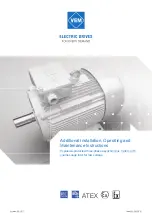
www.parkermotion.com
Parker Hannifi n Corporation
Electromechanical Automation Division
8
When using linear encoders it is critically important to have proper
mounting of the scanner (read) head. Inadequate mounting may cause
mechanical resonance effects and errors in the measured position
caused by vibration of the sensor head. In this case, the achievable
bandwidth of the control loop – and hence, the maximum positioning
stiffness – is reduced considerably. In some cases, large gaps of
positional information are lost entirely, rendering the system totally
inaccurate.
If the linear scale is not aligned straight with the guide bearings,
accuracy can be affected in the form of “cosine errors.” (Fig. 18) shows
a representation of how linear encoder scale misalignment can cause
cosine errors.
The actual distance traveled will be L, where
L=Lenc(cos
Θ
)
. The size
of the error will be
error = Lenc(1 – cos
Θ
)
. Thus, it is important to pay
attention to the mounting of the read head as well as providing robust
attachment and accurate alignment of the linear scale.
Fig. 19: Parker’s ACR Controller Gantry Lock Feature
Θ
L
enc
L
)
(cos
L
L
enc
Θ
=
Linear bearings
Encoder scale
Carriage
Θ
L
enc
L
)
(cos
L
L
enc
Θ
=
Θ
L
enc
L
)
(cos
L
L
enc
Θ
=
L
enc
L
)
(cos
L
L
enc
Θ
=
L
)
(cos
L
L
enc
Θ
=
Linear bearings
Encoder scale
Carriage
Fig. 18: Cosine errors caused by encoder scale misalignment
4.3 Servo Control –
Due to the direct drive nature of linear motors, there are no intermediate
mechanical components or gear reductions to absorb external disturbances
or shock loading. As a result, these disturbances have a signifi cantly
greater impact on the control loop than they would when using other
technologies. For this reason, it is extremely important to have a controller
with fast trajectory update rates. In addition, it is important to have a
controller which allows you manipulate “feedforward” control of speed,
acceleration, and jerk. These parameters allow the user to minimize
tracking errors during acceleration, deceleration, and during external
disturbances.
By defi ning parameters like jerk within your move profi le, the tracking
accuracy of highly dynamic moves can be improved, stresses on the
mechanical system can be reduced, and excitation of mechanical
resonances can be minimized. In addition, payloads that must
be handled gently can still have optimized move profi les with the
implementation of jerk-limited setpoint generation. Parker’s
ACR
and
Compax3
families of controllers allow optimization of all feedforward
parameters and provide extremely fast trajectory update rates for
superior control of linear motors.
Another common control challenge of linear motor systems is the control
of gantry robots. Unlike belt- and screw-driven gantries where the
transmissions of parallel axes can be mechanically connected, linear
motor gantries have no mechanical coupling whatsoever. If tight control
is not provided between these axes, binding and mechanical damage
can occur. Traditional “master – follower” control schemes do not work
well with gantries because the follower axis can bind but the master axis
will be unable to recognize it.
Parker’s
ACR
series of controllers have a
gantry lock function
which pro-
vides skew compensation for gantry systems. By locking the feedback of
each axis into the servo loop of the other, perfect coordination between
axes is established to prevent binding and mechanical damage.






























